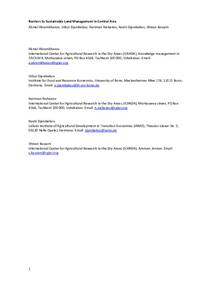Barriers to Sustainable Land Management in Central Asia

Authors:
Humans depend on land resources for provisions, and the sustainability of land capital to provide sustenance becomes invaluable with population growth. Agriculture is one of the major economic sectors of the five ‘stans’, contributing about 5% to 20% of their GDP (World Bank, 2014a). The diversity of reforms in agriculture produced a variety of challenges for sustainable development in each country of the region. An increasing number of reports suggest a growing understanding among diverse groups of stakeholders that the inappropriate exploitation of land resources results in land degradation, and a decrease or complete loss of productivity. Despite the changes in crop portfolio, farm structures, land reforms, agricultural productivity, resource use and agricultural policies, the agricultural sector has remained important in terms of employment, rural livelihoods, food security and government earnings and therefore for economic development in the region.
